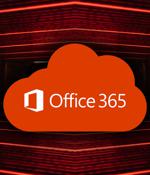Security News

British outsourcing services provider Capita announced today that a cyberattack on Friday prevented access to its internal Microsoft Office 365 applications. The cyber incident prompted the Capita on March 31 to announce an IT issue that impacted its internal systems.

New research from Microsoft's Threat Intelligence team exposed the activities of a threat actor named DEV-1101, which started advertising for an open-source phishing kit to deploy an adversary-in-the-middle campaign. According to Microsoft, the threat actor described the kit as a phishing application with "Reverse-proxy capabilities, automated setup, detection evasion through an antibot database, management of phishing activity through Telegram bots, and a wide range of ready-made phishing pages mimicking services such as Microsoft Office or Outlook."

New research has disclosed what's being called a security vulnerability in Microsoft 365 that could be exploited to infer message contents due to the use of a broken cryptographic algorithm. Office 365 Message Encryption is a security mechanism used to send and receive encrypted email messages between users inside and outside an organization without revealing anything about the communications themselves.

Microsoft Office 365 Message Encryption claims to offer a way "To send and receive encrypted email messages between people inside and outside your organization." Office 365 Message Encryption relies on a strong cipher, AES, but WithSecure says that's irrelevant because ECB is weak and vulnerable to cryptanalysis regardless of the cipher used.

We're not quite sure what to call it right now, so we referred to it in the headline by the hybrid name Microsoft Office 365. The web-based versions of the Office tools don't have the same feature set as the full apps, so any results we might obtain are unlikely to align with how most business users of Office, ah, 365 have configured Word, Excel, Outlook and friends on their Windows laptops.

WithSecure researchers are warning organizations of a security weakness in Microsoft Office 365 Message Encryption that could be exploited by attackers to obtain sensitive information. OME, which is used by organizations to send encrypted emails internally and externally, utilizes the Electronic Codebook implementation - a mode of operation known to leak certain structural information about messages.

Security researchers at WithSecure, previously F-Secure Business, found that it is possible to partially or fully infer the contents of encrypted messages sent through Microsoft Office 365 due to the use of a weak block cipher mode of operation. Organizations use Office 365 Message Encryption to send or receive emails, both external and internal, to ensure confidentiality of the content from destination to source.

Resecurity, a Los Angeles-based cybersecurity company protecting Fortune 500 worldwide, identified a new RAT advertised in Dark Web and Telegram called Escanor. The threat actors offer Android-based and PC-based versions of RAT, along with HVNC module and exploit builder to weaponize Microsoft Office and Adobe PDF documents to deliver malicious code.

This article will explain why users should block macros in Internet downloads and how you can block them in Microsoft Office. To prevent this distribution method, Microsoft announced in February that Microsoft Office would automatically block VBA macros in documents downloaded from the Internet starting in June.

A "Dangerous piece of functionality" has been discovered in Microsoft 365 suite that could be potentially abused by a malicious actor to ransom files stored on SharePoint and OneDrive and launch attacks on cloud infrastructure. The cloud ransomware attack makes it possible to launch file-encrypting malware to "Encrypt files stored on SharePoint and OneDrive in a way that makes them unrecoverable without dedicated backups or a decryption key from the attacker," Proofpoint said in a report published today.